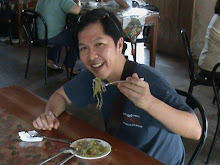
Kaibigan,
Mae Paner, a friend, great actress (you missed half of your life if you didn’t see her poignant portrayal of the squatter idiot savant in the play version of Insiang), and talented television director (her 30-seconder infomercial has singularly catapulted this politician into the Senate stratosphere) had a recent brush with irony.
Feeling in the dumps by the growing state of inertia, helplessness and confusion brought about by—among other things—our community’s seeming collective helplessness in addressing issues of government corruption, hopelessnes and general distopia, the usually happy Mae, thought of coming up with her version of Lupang Hinirang. It is her hope that her work would ignite people into seriously taking stock of the possibilites of positive change. Originally shot in video, she has offered to get this version blown up to film for her plan to get it played in movie houses as is the current practice before the first and last showings of the day.
So what’s the problem?
The provisions of Republic Act 8491 (also known as the Flag and Heraldic Code of the Philippines) prescribe, by almost exact dimensions, the manner of carriage and usage of the Philippine flag. More importantly to Mae’s case, the law also stipulates the proper way to sing Lupang Hinirang. Meaning: one must not only sing in tune, but sing in the time signature that the the song was originally written. Harking back to that first day of official independence from Spanish colonial rule, section 37 of the law states that:
“SECTION 37. The rendition of the National Anthem, whether played or sung, shall be in accordance with the musical arrangement and composition of Julian Felipe.”
How hard can that be, right? Well, that provision of the law is giving my friend, Ms. Paner, anxious days and sleepless nights.
Maestro Felipe’s original arrangement is in 4/4 time signature, a marching beat. On the other hand, Ms. Paner conceptualized and directed her version of our national anthem in a much slower tempo.
When Mae consulted with me on the matter, I offered to write to the National Historical Institute to request for a clearance. Under section 52 of the same law, the National Historical Institute is responsible for the strict enforcement of the provisions of this Act. When I called the NHI to follow up this letter, the ever-helpful Deputy Director Mely Almosara informed me that the NHI Board has taken initiatives to clarify the implementing rules for the singing of the national anthem. The NHI, she says, will be holding a public hearing to get the opinions of various sectors to agree to general principles.
Paner’s interpretation of our national anthem is encapsulated in a young boy’s determination to plant a downtrodden Philippine flag to the top of a flagpole by climbing it, slipper-less, to the top in palo-sebo style. It may sound cliché, but its just the inability of my words to exactly describe the effect of this work.
Who can say that a slower-paced rendition of the song will be less patriotic than when sung in the way the law requires? In short, can nationalism be legislated?
Take this test. Free yourself from all distractions and give this work two minutes of your time. It is important that you approximate the conditions of reverence that the anthem requires. Hey, I multi-task all the time, myself. But viewing the work while eating chips, web-surfing, having an argument with your boyfriend or some similar circumstance will not be fair to the work. Think of it this way: When the national anthem is played, arent’ we expected to pay attention?
After you’ve put yourself in the proper mode, click on the link:
http://youtube.com/watch?v=UmenrO3l88U
Write me what you think?
Or better yet, if you think that the National Historical Institute will be benefitted by your inputs regarding the issue of whether or not there should only be one way of singing our song, email them (copy furnish me, please) at : nhigov.ph@gmail.com atttention: Teddy Atienza, Heraldry Division.



2 comments:
I think the proscription (is that the right term?) on how the national anthem could be legally sung officially was meant to prevent it from being mangled by re-arrangements that would basically have the singer scream it out, "birit" style. Naninigurado lang. But you're right I agree that there's more than one way to sing the National Anthem reverently.
I agree with you. I'll check the implementing rules and regulations of the NHI and clarify this matter further. Hey Anna, thanks for dropping by. Looking forward to watching your play in VLF.
Post a Comment